Listen What I Gotta Say: Women in the Blues
Lesson Hub 9:
Blues Royalty: Women Who Ruled the Blues
6th grade–8th grade

Why were some blues women bestowed with titles of royalty?
Ma Rainey and the Rabbit Foot Minstrels, by Gilles Petard. PD-old, via Wikimedia Commons.
The question to consider in this lesson is . . .


Blues Royalty: Women Who Ruled the Blues
30+ MIN
Bessie Smith, by Carl Van Vechten, Public Domain. National Portrait Gallery.

Legendary Blues Women
Path 1

20+ minutes

Empress of the Blues, by Romare Bearden. Smithsonian American Art Museum.
Legendary Blues Women
Many blues women, though sparsely acknowledged in the history of the blues, have been bestowed with well-earned titles of royalty.



Why Titles of Royalty?
According to the Oxford English Dictionary, the term royalty is sometimes used to describe "the most successful, famous, or highly regarded members of a particular group."
Outstanding performer
How do you think the blues women who were granted "royalty" status earned these titles? (In other words, how did they outshine other blues musicians of the time?)
Creator of a certain style
Does something different
Inspires future artists (descendents)
Accomplishes something new
Learn About the Legends!

Each blues women listed here was bestowed with a title of royalty.
Choose which blues woman you'd like to learn more about:
Mamie Smith: Queen of the Blues
Mamie Smith (May 26, 1891 – September 16, 1946) began her career as a Vaudeville singer, dancer, pianist and actress.


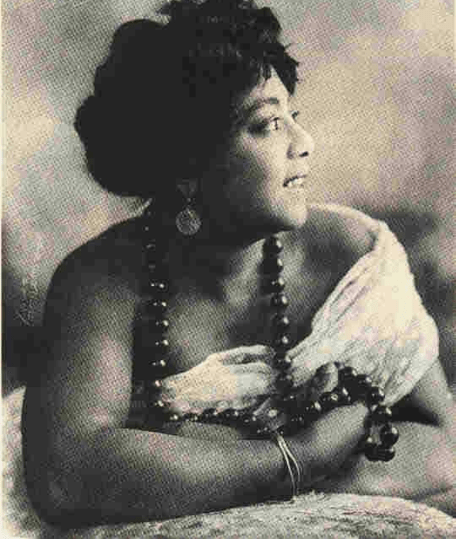
Mamie Smith, unknown photographer. PD-old-70, via Wikimedia Commons.
A performer of the classic blues style, Smith is best known for being the first African American artist (male or female) to make a vocal blues recording in 1920—"Crazy Blues”—launching the nation-wide popularity of the blues to both Black and white audiences.
Mamie Smith: "Crazy Blues"
Take a moment to listen to an excerpt from the very first vocal blues recording: “Crazy Blues”- by Mamie Smith and the Perry Bradford Jazz Hounds.


Any general thoughts about the recording?
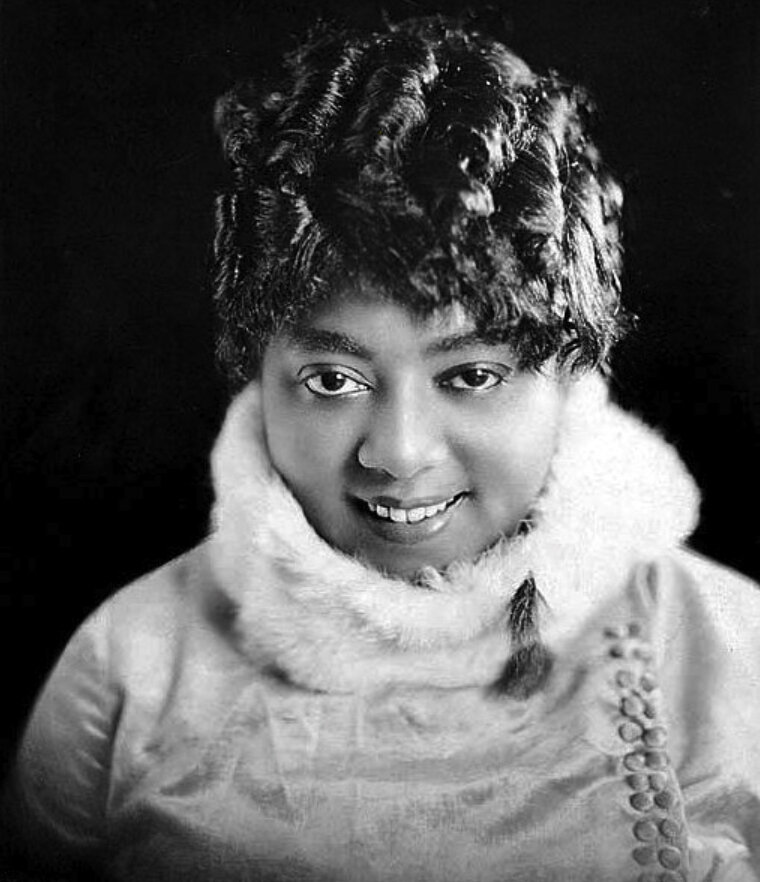
Mamie Smith Portrait, unknown photographer. PD-old-70, Cincinnati Sites and Stories.

I can't sleep at night;
I can't eat a bite;
'cause the man I love
he don't treat me right.
He makes me feel so blue,
I don't know what to do.
Sometime I sit and sigh
and then begin to cry;
'cause my best friend
said his last goodbye.
There's a change in the ocean,
change in the deep blue sea, my baby.
I'll tell you folks, there ain't no
change in me.
My love for that man will always be;
Now I can read his letters;
I sure can't read his mind.
I thought he's lovin' me;
He's leavin' all the time;
Now I see my poor love was blind;
Now I got the crazy blues.
Since my baby went away;
I ain't got no time to lose;
I must find him today.
Now the doctor's gonna do all that
he can,
but what you're gonna need is an undertaker man.
I ain't had nothin' but bad news;
Now I got the crazy blues.
Lyrics of "Crazy Blues" by Mamie Smith
Any general thoughts about the recording?
Generally Speaking .....
Reflection

Why was Mamie Smith given the title "Queen of the Blues"?
Outstanding performer?
Creator of a certain style?
Does something different?
Inspires future artists (descendants)?
Accomplishes something new?
???
Bessie Smith: Empress of the Blues
Bessie Smith (April 15, 1894 – September 26, 1937) was a famous classic blues musician and composer. Like many other African American musicians of the time, Smith was trained through the Vaudeville and minstrel traditions. However, she found her niche as a blues woman.


Smith is well-known for her confident demeanor and success during the Harlem Renaissance. She became the highest paid Black entertainer during this time (1920s–1930s).

Bessie Smith: "A Good Man Is Hard to Find"
Take a moment to listen to an excerpt from one of Bessie Smith's most famous songs: "A Good Man is Hard to Find."


Any general thoughts about the recording?
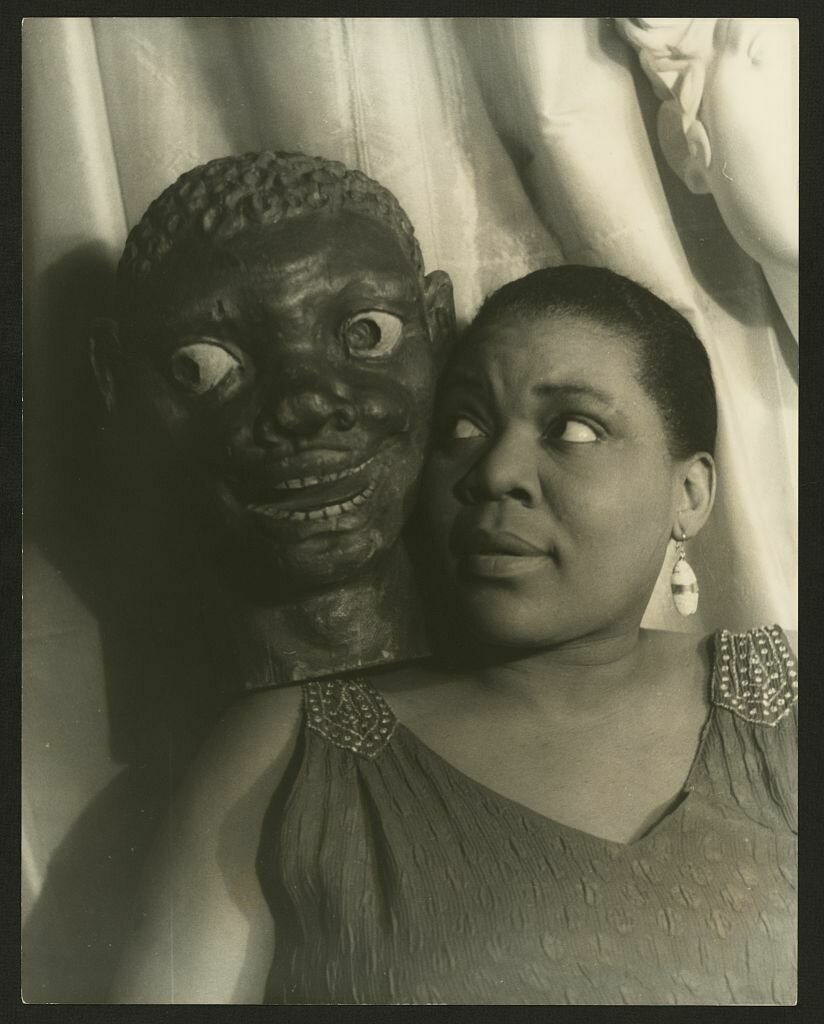
Portrait of Bessie Smith, by Carl Van Vechten. Public Domain, Library of Congress.

My heart is sad and I'm all alone;
My man's treating me mean;
I regret the day that I was born;
And the man I ever seen.
My happiness is less today;
My heart is broke, that's why I say;
Lord, a good man is hard to find;
You always get another kind.
Just when you think that he's your pal;
You look and find him foolin' 'round some old gal.
Then you rave, you all crave;
You want to see him in his grave.
So if your man is nice, take my advice;
Hug him in the morning,
kiss him at night;
Lyrics of "A Good Man is Hard to Find" by Bessie Smith
Any general thoughts about the recording?
Give him plenty lovin';
Treat your good man right.
Oh, a good man is so hard to find;
We always get that roughed old kind;
Just when you think that he's your pal;
You like and find him hangin' 'round some old gal.
Then you rave, how you crave;
You wanna see him dead layin' in his grave.
So if your man is nice, take my advice;
Hug him in the morning;
Kiss him at night;
Give him plenty love madam,
treat your man right;
'Cause a good man nowadays sure is hard to find.
Generally Speaking .....
Reflection

Why was Bessie Smith given the title "Empress of the Blues"?
Outstanding performer?
Creator of a certain style?
Does something different?
Inspires future artists (descendants)?
Accomplishes something new?
???

Ma Rainey: Mother of the Blues
Gertrude "Ma” Rainey (September 1882 or April 26, 1886 – December 22, 1939) was one of the earliest know blues icons. She was essential in transforming the "blues singer" from being a local figure to a professional nationally-known icon.



Called the "Mother of the Blues," Rainey challenged gender norms through her dress, vocal quality, and lyrical content, and helped to introduce the blues to the broader United States.
Ma Rainey, unknown photographer. PD-US Expired, via Wikimedia Commons.
Ma Rainey: "Traveling Blues"
Take a moment to listen to an excerpt from Ma Rainey's "Traveling Blues."


Any general thoughts about the recording?

Ma Rainey and the Rabbit Foot Minstrels, by Gilles Petard. PD-US expired, via Wikimedia Commons.

Train's at the station, I heard the whistle blow;
The train's at the station, I heard the whistle blow;
I done bought my ticket and I don't know where I'll go.
I went to the depot looked up and down the board;
I went to the depot looked up and down the board;
I asked the ticket agent "Is my town on this road?"
The ticket agent said "Woman, Don't sit and cry";
The ticket agent said "Woman, Don't you sit and cry";
The train blows at this station, but she keeps on passing by.
I hear my daddy calling some other woman's name;
I hear my daddy calling some other woman's name;
I know he don't need me but I'm gonna answer just the same.
I'm dangerous and blue, can't stay here no more;
I'm dangerous and blue, can't stay here no more;
Here come my train folks, and I've got to go.
Lyrics of "Traveling Blues" by Ma Rainey
Any general thoughts about the recording?
Generally Speaking .....
Reflection

What about Rainey’s life or performance style made her worthy of the title “Mother of the Blues.”
Outstanding performer?
Creator of a certain style?
Does something different?
Inspires future artists (descendants)?
Accomplishes something new?
???
Victoria Spivey: Queen Victoria (Queen Vee)
Throughout her lengthy career, Queen Victoria performed and collaborated with many famous musicians (Louis Armstrong, King Oliver, Lonnie Johnson, and Bob Dylan, just to name a few).



Victoria Spivey, photo by Diana Jo Davies. Ralph Rinzler Folklife Archives and Collections, Smithsonian Institution.
Victoria Regina Spivey (October 15, 1906 – October 3, 1976) was a blues singer, pianist, and songwriter. Her career, unlike others during this era, lasted over 50 years.
In 1961, Victoria Spivey co-founded her own record company (Spivey Records).
Victoria Spivey: "You're My Man"


Any general thoughts about the recording?

Take a moment to listen to an excerpt from Victoria Spivey's "You're My Man."

I been locked up so long, don't think I can even walk straight.
In this cold cell so long, don't believe I can walk straight.
But they just gave me my lil bundle and gave the man the key to the gate.
You caused me to be here, been here so doggone long.
You cause me to be here, been here so doggone long.
Darlin when I come home, please don't let me catch you wrong.
Had to find myself a small gun, a pocketknife too.
I don't wanna catch none of those broads with you.
You're my man I'm coming home this very day.
You better tell all of those lil dolls that they better stay away.
Lyrics of "You're My Man" by Victoria Spivey
Any general thoughts about the recording?

Story behind "You're My Man"
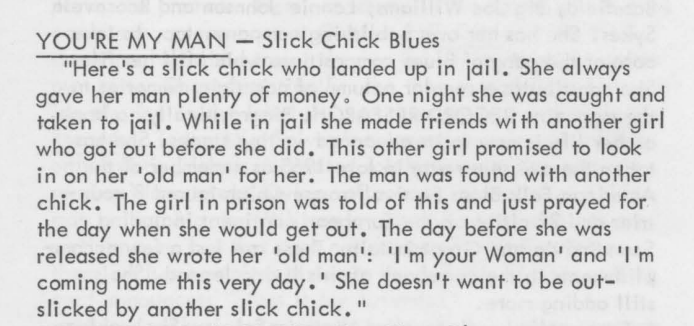
"You're My Man" Track Notes, by David Jasen. Folkways Records
How might this story offer or omit details from the lyrics?
What insight does this story provide about the experiences seen and lived by blues women in the early 20th century?
Generally Speaking .....
Reflection

What about Victoria Spivey’s music and career makes her a good pick for the title of Queen Victoria (Queen Vee)?
Outstanding performer?
Creator of a certain style?
Does something different?
Inspires future artists (descendants)?
Accomplishes something new?
???
Vaudeville

Vaudeville was a popular type of live stage entertainment in the early 20th century, consisting of various speciality acts (e.g., singing, dancing, instruments, comedy, skits, performing animals, etc.).
Why do you think working in Vaudeville was good training for blues women?
You may have noticed that many of our famous blues women worked in "Vaudeville" before becoming blues women.
Federal WPA Variety Presents Vaudeville, by Richard Halls. Library of Congress.
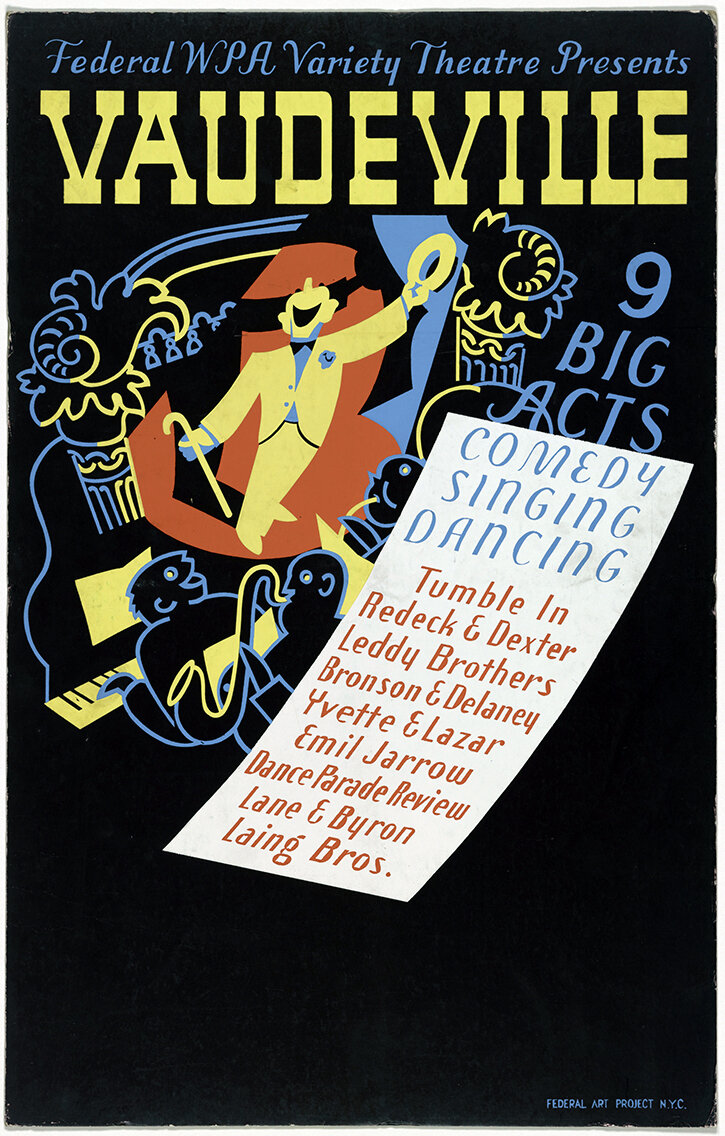
Blues Women and Vaudeville

Vaudeville, by Jacob Lawrence. Hirshhorn Museum and Sculpture Garden, Smithsonian Institution.
Through working in Vaudeville, these women developed many important skills.

In addition to learning to sing in different styles, they sometimes learned to dance, act, and play instruments (among other skills).
They also gained valuable experience performing in front of large crowds, which helped them develop confidence and stage presence ... traits that helped them become successful solo artists.
Closing Discussion: Compare and Contrast

How did these trailblazing blues women stand out compared to other blues performers?
What are some similarities and differences between their music and careers?
Learning Checkpoint

- Who were four trailblazing blues women in the early 20th century, and why were their contributions so pivotal to the popularization of the genre?

End of Path 1: Where will you go next?


Songs of Queens
Path 2

25+ minutes

"Queen" Victoria Spivey, photo by Diana Jo Davies. Ralph Rinzler Folklife Archives and Collections, Smithsonian Institution..
Generally Speaking .....
Songs of Queens

We often admire blues women for their cunning lyrics and sultry voices, but ...
How often do we recognize their contributions as composers?
Women Who Ruled the Blues
In Component 1, we introduced four important blues women who were bestowed with titles of royalty because their contributions were so pivotal to the popularization of the genre.





Left to Right: Mamie Smith Portrait, unknown photographer. PD-old-70, Cincinnati Sites and Stories. Portrait of Bessie Smith, by Carl Van Vechten, Public Domain. National Portrait Gallery. Ma Rainey, unknown photographer. PD-US Expired, via Wikimedia Commons.Victoria Spivey, photo by Diana Jo Davies. Ralph Rinzler Folklife Archives and Collections, Smithsonian Institution.
Songs of Queens

Ma Rainey:
“Mother of the Blues”
Only two of these women wrote the lyrics and composed the music for the songs they performed.
Can you guess who?
Mamie Smith: “Queen of the Blues”
Bessie Smith:
“Empress of the Blues”
Victoria Spivey: “Queen Victoria”
"Crazy Blues"
"A Good Man is Hard to Find"
"Traveling Blues"
"You're My Man - Slick Chick Blues"
Spotlight: Victoria Spivey


Victoria Regina Spivey (October 15, 1906 – October 3, 1976) was an important blues singer. Her career, unlike most others during this era, lasted over 50 years.
In addition to performing in different blues styles throughout her five-decade career, "Queen Vee" played the piano, composed her own songs, and co-founded her own record label: Spivey Records.
To better understand her expertise as both a composer and performer, we should analyze her music more closely.

Victoria Spivey: "You're My Man"

In the next part of this lesson, we will listen closely to a song Victoria wrote and originally released on her own label: "You're My Man."
The Blues Is Life, Victoria Spivey, cover design by Ronald Clyne. Folkways Records.
Attentive Listening: Structure

As you listen to the whole track, try to identify the structure (different sections of the song). Are all the sections different? Is there any repetition?
When you think a section has ended, raise your hand.
If a section repeats, say "repeat" out loud (to indicate you have heard this before).
"You're My Man," by Victoria Spivey
Fun with Chord Changes

| I | I or IV | I | I7 |
|---|---|---|---|
| IV | IV | I | I7 |
| V | V or IV | I | I or V |
Standard 12-bar blues chords
- Each time you hear a new chord (the chord change), clap your hands.
- Try to sing the chord changes (sing the root note at the beginning of each measure).
- Play the chord changes (root note) on an instrument.
Your teacher will play the 12-bar blues progression.
Attentive Listening: Instruments

Listen to another excerpt from this track.
What instruments do you hear?
"You're My Man," by Victoria Spivey
Attentive Listening: Pitch

The use of dissonance through blue notes is common in blues and jazz music.
"You're My Man," by Victoria Spivey
Blue notes are created by raising or flattening the pitch, which creates an unexpected, dissonant sound.
Listen again:
Raise your hand when you hear blue notes or dissonance.

I been locked up so long, don't think I can even walk straight.
In this cold cell so long, don't believe I can walk straight.
But they just gave me my lil bundle and gave the man the key to the gate.
You caused me to be here, been here so doggone long.
You cause me to be here, been here so doggone on long.
Darlin when I come home, please don't let me catch you wrong.
Had to find myself a small gun, a pocketknife too.
I don't wanna catch none of those broads with you.
You're my man I'm coming home this very day.
You better tell all of those lil dolls that they better stay away.
How do you interpret these lyrics: What story is she telling?
Attentive Listening: Lyrical Meaning

Story behind "You're My Man"

The Blues is Life Liner Notes Excerpt, by David Jasen. Folkways Records
How might this story offer or omit details from the lyrics?
What insight does this story provide about the experiences seen and lived by blues women in the early 20th century?

I been locked up so long, don't think I can even walk straight.
In this cold cell so long, don't believe I can walk straight.
But they just gave me my lil bundle and gave the man the key to the gate.
You caused me to be here, been here so doggone long.
You cause me to be here, been here so doggone long.
Darlin when I come home, please don't let me catch you wrong.
Had to find myself a small gun, a pocketknife too.
I don't wanna catch none of those broads with you.
You're my man I'm coming home this very day.
You better tell all of those lil dolls that they better stay away.
Thinking about the lyrics and their meaning, how do you think that the music Queen Victoria composed connects to the lyrical content—if at all?
Attentive Listening: Expressive Qualities
When does the dissonance occur? Does her vocal quality or expressive choices relate to the lyrical content in any way?
Engaged Listening: Time / Tempo

Listen again, paying attention to Queen Vee's use of time.
Tap your toe or softly tap/clap along on beats 2 and 4.
-
Take note of and adjust to changes in tempo.
- How do these tempo changes help to convey expressive intent?
"You're My Man," by Victoria Spivey
Optional: Compare and Contrast
The first song she ever wrote and released, "Black Snake Blues"(1926), is one that inspired recordings by other well-known blues artists.

As we mentioned earlier, Victoria performed and worked with many famous musicians during her career: Louis Armstrong, King Oliver, Lonnie Johnson, and Bob Dylan, to name a few.
If time allows, compare and contrast tracks from three different performers: Victoria Spivey (the original), Blind Lemon Jefferson, and Clifton Chenier.
Learning Checkpoint
- What set Victoria Spivey apart from other blues women of her time?
- How did "Queen Victoria" use her compositional skills (musical elements and expressive qualities) to convey expressive intent (meaning)?


End of Path 2: Where will you go next?

Celebrating Blues Women
Path 3
30+ minutes


Ma Rainey, unknown photographer. PD-US Expired, via Wikimedia Commons.
Celebrating Blues Royalty
In Component 1, we introduced four important blues women who were bestowed with titles of royalty because their contributions were so pivotal to the popularization of the genre.





Left to Right: Mamie Smith Portrait, unknown photographer. PD-old-70, Cincinnati Sites and Stories. Portrait of Bessie Smith, by Carl Van Vechten, Public Domain. National Portrait Gallery. Ma Rainey, unknown photographer. PD-US Expired, via Wikimedia Commons.Victoria Spivey, photo by Diana Jo Davies. Ralph Rinzler Folklife Archives and Collections, Smithsonian Institution.
Celebrating Blues Royalty

Not only were these blues women bestowed with titles of royalty ... they were also commemorated through the works of other artists, such as poet and scholar Sterling Brown, and composer and storyteller Perry Bradford.
Left: The Poetry of Sterling Brown, cover art by Caroline Brownell. Smithsonian Folkways Recordings. Right: Perry Bradford, unknown photographer, PD-US expired, via Internet Archives.


Praising Ma Rainey
On a Smithsonian Folkways album released in 1995, poet and educator Sterling Brown wrote a poem commemorating the work of blues women, Ma Rainey.



What do you think Sterling Brown meant by the line: "She just gets hold of us, thataway"?
"Ma Rainey," written and read by Sterling A. Brown.

Listen and Reflect
What do you notice about Sterling Brown's style of reading the poetry?

"Ma Rainey," written and read by Sterling A. Brown.
Listen again:

Why Vernacular?

Vernacular is a term used to describe the language or dialect spoken by the ordinary people in a particular country or region.

Sterling Brown in a University Classroom, by Roy Brown. Smithsonian Folkways Recordings.
Sterling Brown was a literature professor at Howard University (an HBCU). He intentionally used vernacular in his poetry.
According to Brown, he sought to preserve this African American performance tradition instead of replicating the performance tradition of white Americans- which is often thought to be more “correct”.
Reminiscing About Bessie Smith

Perry Bradford, the African American composer who wrote “Crazy Blues”(recorded by Mamie Smith), was an advocate for the recording and publishing of blues artists.
For you, what is the most interesting part of this story?

"Reminiscing About Bessie Smith," by Perry Bradford
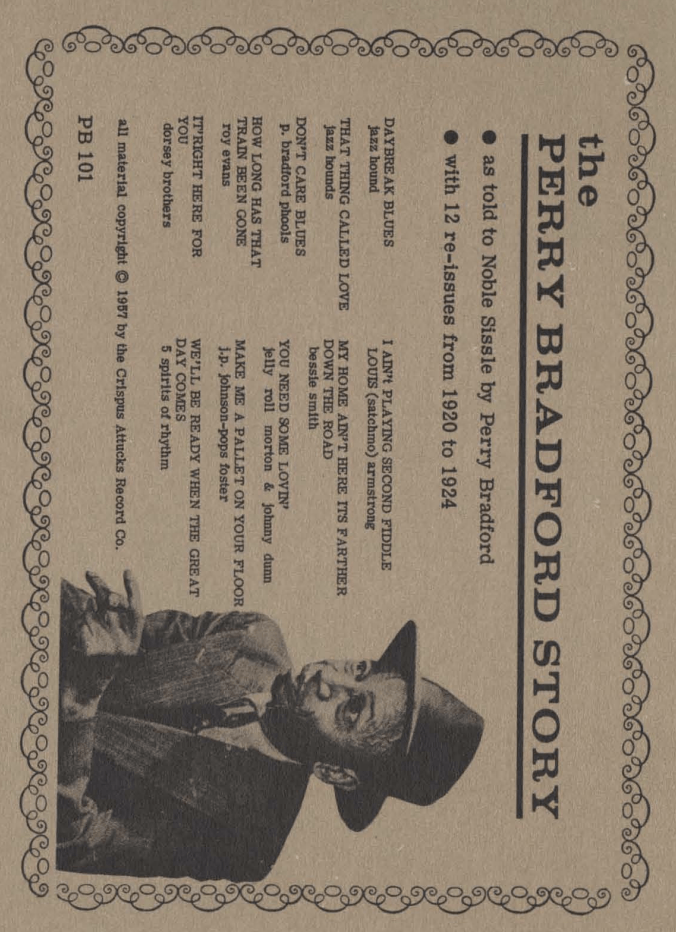
The Perry Bradford Story, cover design by Ronald Clyne. Folkways Records.
Why Storytelling?

Storytelling involves a two-way interaction between a storyteller and listeners.

The Storyteller, by Kathleen Atkins Wilson. Courtesy of the artist.
Storytelling has always been an important part of African American culture.
Why?
Oral Transmission and African American History

Oral transmission occurs when knowledge is passed from one person's mouth to another person's ear.
Since enslaved Africans were forbidden from learning how to read and write, oral transmission was very important.
Examples of knowledge passed down through oral transmission in African American communities include stories of legacies and family generations, songs, values, and traditions.

Field Workers, by Ellis Wilson. Smithsonian American Art Museum.
Storytellers

Just as written transmission (e.g., books) is appreciated and delivered with details, imagery, and texture (e.g., metaphor, rhyme), oral transmission is performed in the same way.
Good storytellers offer a vivid picture to their listeners, keeping them captivated, engaged, and (hopefully) able remember the message (fiction or non-fiction).

Are there any good storytellers in your family?
Mother Telling Stories, by unknown artist. Public Domain, via Karen's Whimsy.
What About Victoria Spivey?

In this Component, we listened to a poem that celebrated Ma Rainey and a story about Bessie Smith and Mamie Smith.
But ... what about the fourth "royal" blues woman we have learned about in this lesson?
That's where you come in!
Creative Activity: Write a Poem or Tell a Story

Next, YOU will have an opportunity to write a poem or craft a story about the blues woman known as "Queen Victoria".
Although Victoria Spivey is not as well-known as some other blues women we have discussed in this lesson, she had a very interesting and long life (and career).

Learning Through Liner Notes

First, take some time to learn more about Victoria Spivey's life, music, and experiences by reading several excerpts from the liner notes that accompany her album, The Blues is Life.

The Blues is Life by Victoria Spivey, cover design by Ronald Clyne. Folkways Records.
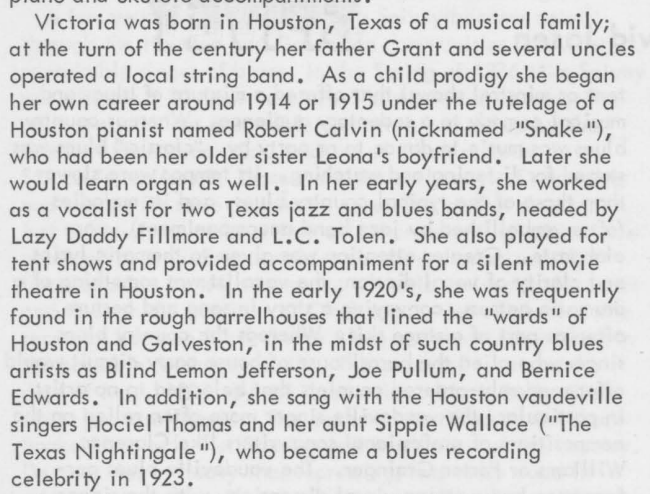
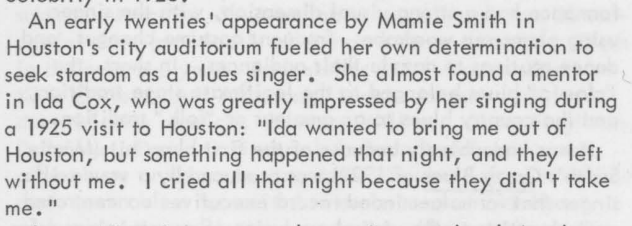
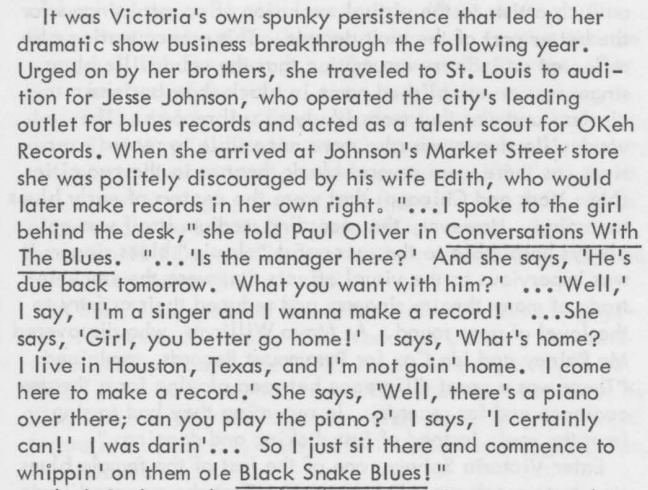
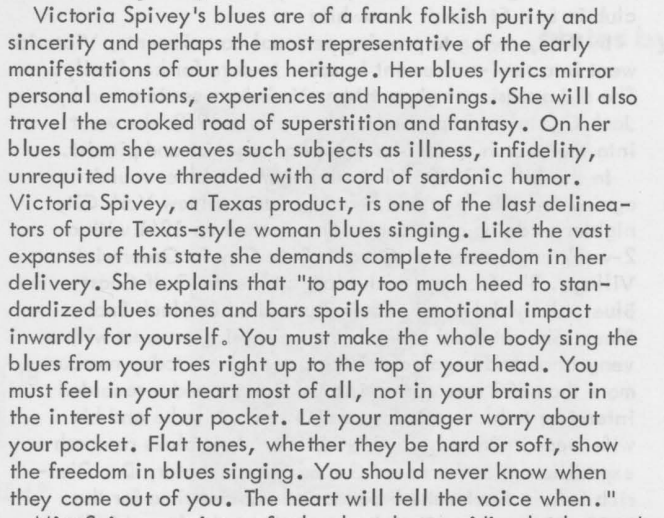

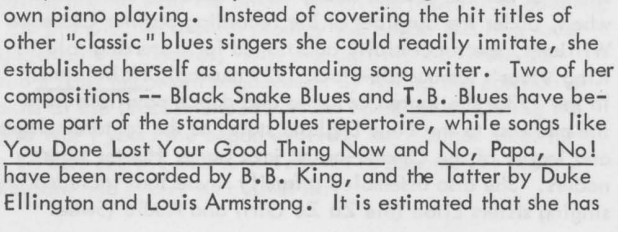


The Blues is Life Liner Notes, written by David Jasen. Folkways Records.
Write Your Story or Poem

Like Sterling Brown and Perry Bradford, it is time for you to commemorate Victoria Spivey's music and/or life by crafting a compelling story or poem.
- As you work, refer back to the liner note excerpts for inspiration.
- As you work, consider the performance style and the significant role that oral/aural traditions play in African American culture.
- Once complete, rehearse your poem / story and perform it for the class (your final performance only needs to be 2–3 minutes ).
A few suggestions:
Victoria Spivey: Queen Victoria (Queen Vee)
Throughout her lengthy career, Queen Victoria performed and collaborated with many famous musicians (Louis Armstrong, King Oliver, Lonnie Johnson, and Bob Dylan, just to name a few).



Victoria Spivey, photo by Diana Jo Davies. Ralph Rinzler Folklife Archives and Collections, Smithsonian Institution.
Victoria Regina Spivey (October 15, 1906 – October 3, 1976) was a blues singer, pianist, and songwriter. Her career, unlike others during this era, lasted over 50 years.
In 1961, Victoria Spivey co-founded her own record company (Spivey Records).
Victoria Spivey: "You're My Man—Slick Chick Blues"


Any general thoughts about the recording?

Take a moment to listen to an excerpt from Victoria Spivey's "You're My Man—Slick Chick Blues."

I been locked up so long, don't think I can even walk straight.
In this cold cell so long, don't believe I can walk straight.
But they just gave me lil bundle and gave the man the key to the gate.
You caused me to be here, been here so doggone long.
You cause me to be here, been here so doggone on long.
Darlin when I come home, please don't let me catch you wrong.
Had to find myself a small gun, a pocketknife too.
I don't wanna catch none of those broads with you.
You're my man I'm coming home this very day.
You better tell all of those lil dolls that they better stay away.
How do you interpret these lyrics: What story is she telling?
Lyrical Meaning: "You're My Man - Slick Chick Blues"

Story behind "You're My Man—Slick Chick Blues"

The Blues is Life Liner Notes Excerpt, by David Jasen. Folkways Records
How might this story offer or omit details from the lyrics?
What insight does this story provide about the experiences seen and lived by blues women in the early 20th century?
Optional: Musical Storytelling

Can you incorporate music into your storytelling?
-
Add an accompanying melody or rhythmic pattern to the words.
-
Consider the structure: Are there sections with only music (no words)? Sections with both? Is the music meant to accompany (not to overshadow) the story?
-
Can you use musical sounds or instruments to provide an aural representation of the words being read? (e.g. dissonance or slow tempo for sadness, fast tempo or short/quick notes for quick motion)?
-
Like blues musicians, can you use instruments to mimic voices and tell your story?
-
Be creative!
A few suggestions:
Learning Checkpoint
- Why is storytelling an important part of African-American culture?
- Why have some African American poets and storytellers used vernacular forms of expression in their creative works?
- What are some key attributes of a good storyteller?



End of Path 3 and Lesson 4 Hub: Where will you go next?

Lesson 9 Media Credits

Audio courtesy of
Smithsonian Folkways Recordings
Columbia Records
Images courtesy of
Library of Congress
Danielle Nalangan
Smithsonian American Art Museum
Smithsonian Folkways Recordings
Hirshhorn Museum and Sculpture Garden
National Portrait Gallery
Ralph Rinzler Folklife Archives and Collections
Kathleen Atkins Wilson
Cincinnati Sites and Stories
© 2023 Smithsonian Institution. Personal, educational, and non-commercial uses allowed; commercial rights reserved. See Smithsonian terms of use for more information.
This Lesson was funded in part by the Smithsonian Youth Access Grants Program, with support from the Society for Ethnomusicology and the National Association for Music Education.
For full bibliography and media credits, see Lesson 9 landing page.







